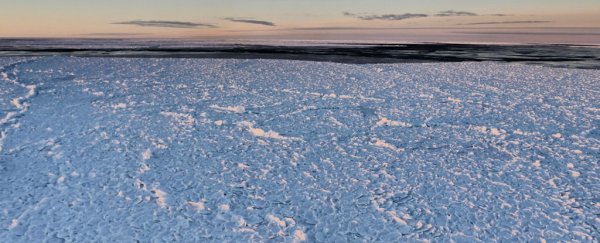Researchers in West Antarctica have observed a rare type of ice formation called "dragon-skin" ice, caused by intense hurricane-strength winds buffeting water as it freezes.
The phenomenon, which researchers say hasn't been seen in Antarctica since 2007, occurs in what's called polynyas – areas of open water surrounded by sea ice – which in strong wind conditions can act like outdoor 'ice factories', producing as much as 10 times as much sea ice as usual.
"Dragon-skin ice is very rare, bizarre, evidence of a darker chaos in the cryospheric realm," says polar oceanographer Guy Williams from Australia's University of Tasmania, referring to the parts of our planet's surface where water exists in frozen form.
In the case of dragon-skin ice, the cryosphere is affected by strong, descending winds called katabatic winds, which enhance ice production by continually lifting up surface ice after it has hardened – exposing and subsequently freezing fresh water sources before the cycle begins anew.
 Guy Williams/University of Tasmania
Guy Williams/University of Tasmania
"Imagine your standard ice cube tray, filled once. After a week, you get one tray of ice cubes. But if you empty and re-fill the tray each night, you get so much more," says Williams.
"That is what the katabatic winds are doing in the polynya, removing the ice, exposing the water, and making more ice form."
Aboard the US ice-breaker research vessel Nathaniel B. Palmer with 26 other scientists, Williams is part of the Polynyas & Ice Production in the Ross Sea (PIPERS) expedition studying how these katabatic winds affect polynyas and sea ice in Antarctica's coastal regions.
The recent dragon-skin ice sighting occurred last week, as the vessel approached "ground zero" of a hurricane-strength katabatic wind event in Terra Nova Bay, as Williams described it on the PIPERS blog:
"It is quite incredible to experience such an epic demonstration of polar ocean-atmospheric interaction. We are so small in comparison to the forces around us, it feels like we are in one of those cheap dodgy kayaks from [budget retailer] Shiploads that has somehow made its way to the bottom of Niagara Falls."
For a vessel as large as the Nathaniel B. Palmer (see below), that's saying something – but the gale didn't just rock the boat, it also produced "kilometre after kilometre" of the dragon-skin ice: small formations of pancake-shaped ice that resemble dragon scales.
 Guy Williams/University of Tasmania
Guy Williams/University of Tasmania
In addition to studying the ice formation, the expedition – which is running until June – will examine how the salt in seawater is rejected during ice formation, and how that phenomenon affects ocean currents and water circulation.
"We will spend the next two weeks in the belly of this ice-breathing dragon," writes Williams, "taking advantage of quiet periods when the katabatics drop off to observe the increase in salinity of the shelf waters below."
